Difference between Electricity and Electronics
In an electrical circuit, the current naturally flows through the conductors and components, and the value of the current depends on the components connected to the circuit.
Electricity and Electronics
The difference between electricity and electronics, or between an electric circuit and an electronic circuit, is that control is exercised over the flow of electric current in the latter.
But this is not new; just imagine putting a switch to control whether or not current flows through a light bulb. This would allow us to control the flow of current through the bulb.
The most important difference lies in how this current flow is controlled. In an electronics circuit, the flow of electric current is controlled by another electrical signal in the form of either another electric current or a fixed voltage.
In other words:
In an electronic circuit … electricity is able to control electricity.
The electronic age began with the Audion tube. This device controlled the flow of an electron beam travelling in a vacuum between two electrodes (metal structures within the tube with a voltage difference between them).
The transistor was invented in 1948. This small device had effects very similar to those of the Audion tube, but was much smaller. Rather than operating in a vacuum, the transistor controls the flow of electrons through a semiconductor material. This type of electronics is also known as solid-state electronics. A transistor controls the flow of current using either current or voltage, whereas a vacuum tube only uses voltage.
It is not possible to send information with an electrical circuit. However, with an electronic circuit, information can be sent from one place to another thanks to its ability to control the flow of current.
Electricity is associated with passive elements, such as resistors, capacitors and inductors. In contrast, electronics is associated with active elements, such as transistors, operational amplifiers, SCRs and TRIACs.
For a circuit to properly qualify as ‘electronic’, it must contain at least one active element. If a circuit contains only passive elements, such as resistors, capacitors, inductors, transformers and rectifier diodes, it is not genuinely electronic.
You may be interested on Static Electricity





